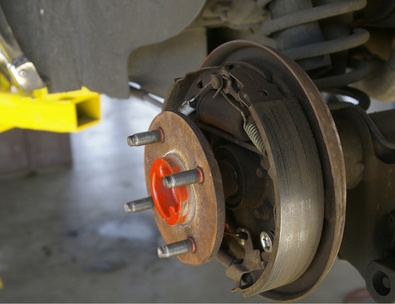
Regular brake maintenance is critical to automotive safety. Disc brake systems are relatively easy to inspect and service, and the novice mechanic can save time and money by doing many of the routine tasks himself. In order to gain access to the disc pads and rotors, it is necessary to learn how to retract the caliper pistons. This relatively simple task must be carried out with care to avoid damaging other brake components.
Jack the car up and secure it on jack stands. Remove the lug nuts then the wheel to access the brake caliper and disc. The brake pads in the caliper should be lightly touching the disc on either side. The piston is on the rear of the caliper, and there is typically a notch in the frame on the front side of the caliper opposite the piston. There should also be an opening in the top of the caliper that allows you to look at the edge of the disc and the brake pads.
Remove the lowest guide bolt on the caliper and pivot the brake caliper upwards. Secure the brake caliper with a wire or bungee cord. Sometimes the brake pads will catch on rust or other deposits that have built up around the outer rim of the brake disc. If this happens, the pistons will have to be retracted slightly to allow the caliper to be pivoted up. Remove the upper guide bolt then slowly but firmly rock the brake caliper back and forth. This should work the brake pads apart enough so that they will clear the rust layer on the outer edge of the disc so that the caliper can be slipped off.
Remove the brake pads by removing the retaining springs (if any are present) and sliding the pads towards the center of the caliper until they are free. You will now clearly see the brake piston on the back of the caliper.
Retract the piston with a brake pad spreader, also known as a brake piston retractor. This tool consists of a small metal plate with a threaded hole in the middle and a threaded spindle passing through the hole. The spindle has a knob or handle on one end and a leveling swivel on the other. To use the tool, retract the swivel end most of the way towards the plate by turning the knob counterclockwise. Place the metal plate against the inside of the caliper opposite the cylinder. Turn the knob clockwise to extend the swivel end of the spindle until the swivel rests securely on the edge of the piston. Continue turning the knob clockwise, slowly and firmly. As the spindle extends, it will push the piston back until it is fully retracted. A C-clamp can also be used to retract the brake piston. Simply hook the clamp's frame over a solid part of the back of the caliper and adjust the spindle until the swivel rests securely on the edge of the piston. Slowly tighten the clamp to retract the piston.